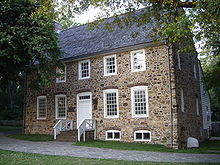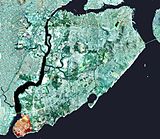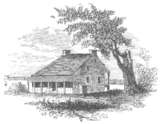- Christopher Billop
-
For his great grandfather, a British naval captain, see Christopher Billopp (captain).
Christopher Billopp (c. 1738 – March 29, 1827) was a British loyalist during the American Revolution who commanded a Tory detachment during the war, earning him the sobriquet, "Tory Colonel". After the American Revolution he emigrated to New Brunswick, Canada along with other United Empire Loyalists and became a politician. He represented Saint John in the 1st New Brunswick Legislative Assembly.
Contents
History
He was born on Staten Island in New York, the eldest of eight children born to Thomas and Sarah Farmar Billopp. His father Thomas was the son of Anne Billopp who married Colonel Thomas Farmar in 1705. Anne Billopp and her sister Mary were the daughters of British sea captain Christopher Billopp who was awarded 932 acres (3.77 km2) of land on the southern tip of Staten Island, where he built a stone manor house he called "Bentley Manor". Billopp served as a colonel in the loyalist forces during the American Revolution. Col. Billopp’s brother, Thomas Farmar (he reassumed the family name Farmar) fought as a private against the British Crown.
Billopp was captured twice by American patriots, one occasion occurred on June 23, 1779, when they rowed across the Arthur Kill from Perth Amboy, New Jersey. He was held as a P.O.W. in the Burlington County, New Jersey jail, where he was chained down to the floor and fed a diet of bread and water by order of Elias Boudinot, appointed by Congress as Commissary General of Prisoners. He was informed that his harsh treatment was in retaliation for the suffering of John Leshler and Captain Nathaniel Fitz Randolph of Woodbridge, New Jersey, being held by the British. Fitz Randolph would later be killed in the Battle of Springfield.
To the Keeper of the Common Jail for the county of Burlington. Greeting.
"You are hereby commanded to receive into your custody, the body of Col. Christopher Billop, prisoner of war, herewith delivered to you, and having put irons on his hands and feet, you are to chain him down to the floor in a close room, in the said jail; and there so detain him, giving him bread and water only for his food, until you receive further orders from me, or the commissary of Prisoners for the State of New Jersey, for the time being. Given under my hand at Elizabeth Town, this 6th day of Nov. 1779.
"ELIAS BOUDINOT, Com. Pris. New Jersey."
"Sir, Sorry I am that I have been put under the disagreeable necessity of a treatment towards your person that will prove so irksome to you; but retaliation is directed, and it will, I most sincerely hope, be in your power to relieve yourself from the situation by writing to New York, to procure the relaxation of the sufferings of John Leshler, and Capt. Nathaniel Randolph. It seems, nothing short of retaliation will teach Britons to act like men of humanity.
"I am, sir, your most humble servant, "ELIAS BOUDINOT, Com. S. Pris.
"Elizabeth Town, Nov. 6, 1779.
Another prisoner being held in the Burlington jail at the same time was John Graves Simcoe of the Queen's Rangers, who led the massacre of patriots in the Wiliam Hancock house in Salem, New Jersey, and embarked on a raid into New Jersey, dubbed "Simcoes Raid", from "Billop's point", as Christopher Billop's land was known. It was upon this raid he was captured and imprisoned with Billop.
Portion of letter to George Washington from John Simcoe;
I was allowed my parole, was taken from it the 9th, and have ever since been confined a close prisoner in Burlington gaol, with Col. Billop, who is in irons and chained to the floor, to retaliate for F. Randolph and Leshier, the latter of whom is (said to be) confined in the same manner in New-York: my mittimus hath not expressed what I am imprisoned for; but, by the tenor of Governor Livingston's letters, I suppose it is to retaliate for the former of those citizens, whom he allows to be a private soldier, and who is simply confined as such.
It was not until after Christmas that Billopp was released in a prisoner exchange. When the war ended he left the newly formed United States of America for New Brunswick in the British colony of Canada.[1][2]
In Canada
Billopp along with his Loyalist father-in-law, Benjamin Seaman moved to Parrtown in New Brunswick in 1783. Parrtown and Carleton were two communities founded by Loyalists from America in the vicinity of Fort Howe. The two communities later merged to form the city of Saint John, New Brunswick. Benedict Arnold, the American revolutionary war traitor, lived in Saint John from 1787 to 1791.
Billopp served in the New Brunswick Assembly and in 1796 was appointed to its council by King George III. In 1823, he was asked to become administrator for New Brunswick following the death of Lieutenant-Governor George Stracey Smyth but refused to come to Fredericton to take the oath of office. Ward Chipman took on this post instead although Billop challenged this appointment.[3]
Marriage and children
He was married twice his first wife (licence issued February 11, 1773) was Francis Willett, born November 2, 1739, daughter of Thomas Willett and of Elizabeth Lawrence, their children;
- Thomas Billopp who married and moved to New York City and started a business venture with his brother John who would later die in a yellow fever epidemic. Thomas later sailed on an expedition to Venezuela on the Leander in 1806, in attempt orchestrated by Francisco de Miranda to start a revolution against Spanish rule in Venezuela. He was given the rank of captain in the revolutionary forces. He along with 60 others were captured by the Spanish on April 28, 1806, and hanged in Porto Caballo, Venezuela on July 26, 1806, where his name is inscribed on a monument in Plaza El Aguila along with other North Americans who died in the conflict with the Spanish Crown.[4][5][6]
- John Willett Billopp born in Staten Island, New York, baptized in St. Andrew's Church in Richmondtown, Staten Island, N.Y. on June 11, 1769, died in 1798 in New York City during a yellow fever epidemic.
- Elizabeth
- Sarah; born December 6, 1765, died 1811.
- Catherine born 1775, died August 28, 1839, married (February 3, 1807) John Black, brother of William Black, born 1764, died 1823:
His second wife was Jane Seaman, born January 16, 1754, died January 21, 1802 in New Brunswick, Canada, daughter of Benjamin Seaman and Elizabeth Mott, their children;
- Louisa Billopp, who married United Empire Loyalist, John Wallace, Esq., Surveyor of Customs. Louisa's portrait was painted, c. 1816, by Robert Field (1769–1819) and was purchased by the Canadian government in 2006 from her descendant Kenneth Wallace.
- Mary Billopp, was born in 1790 and became the second wife of Rev. Archdeacon Willis of Nova Scotia and died on April 11, 1834 at Halifax, Nova Scotia, aged 43. Descendants include Andrew Willis, James Willis, Robin Willis, Nigel WIllis and Tim Willis
- Jane Billopp, died on June 6, 1836, wife of Hon. William Black of St. John, a member of the Legislative and Executive Councils, and for a short time was administrator of the province."
- Anne; born in 1786, died February 9, 1872 in St. John, New Brunswick.
- Katherine
The peace conference
His former New York estate, built by his great-grandfather, was the site of failed peace conference on September 11, 1776, between the Americans, John Adams, Benjamin Franklin and Edward Rutledge and the British, Lord Howe representing the crown. The house is a United States National Historic Landmark, known as the Conference House.[7]
Ghost legend
After his last release from patriot imprisonment Billop went back to his manor house and confronted his servants. He was convinced that a 15-year-old servant girl had signalled his presence on the day of his kidnapping by holding a candle by a window on the second floor. This could be seen by the patriots perched in the steeple of St. Peter's Church in rebel controlled Perth Amboy.
According to legend he threw her down a flight of stairs and killed her. His ghost and that of the girl are said to haunt the Conference House, reenacting their deadly struggle.[8]
Gravestone inscription
His gravestone reads:
Sacred / to / the memory of / the Honorable / Christopher Billopp / A member of His Majesty’s / council in this province, whose / uncompromising loyalty and / distinguished exertions as/ a Lieu. Colonel, in the Royal / cause during the American / rebellion, obliged him at the / termination of that contest, to / abandon without compensation / his hereditary property on Staten / Island, and retire with his family / to this Colony, wherein he has since / resided universally respected./ He died on the 28, day of March / 1827, in the 90th year / of his age.
Bibliography
- The Campaign of 1776 Around New York and Brooklyn By Henry P. Johnston Publisher: BiblioLife (April 30, 2009) Language: English ISBN 0-559-13433-9 ISBN 978-0-559-13433-3
- Early New Brunswick probate records, 1785–1835 By R. Wallace Hale Publisher: Heritage Books (January 15, 2008) Language:English ISBN 1-55613-240-9 ISBN 978-1-55613-240-7
References
- ^ Annals of Staten island, from its discovery to the present time, Volume 1 By J. J. Clute Publisher: General Books LLC (January 2, 2010) Language: English ISBN – 1152217437 ISBN 978-1-152-21743-0
- ^ Morris's Memorial History of Staten Island, New York (Volume 2) by Ira K. 4n Morris Publisher: General Books LLC (January 6, 2010) Language: English ISBN 1-152-42476-9 ISBN 978-1-152-42476-0
- ^ That ever loyal island: Staten Island and the American Revolution By Phillip Papas Publisher: NYU Press; illustrated edition edition (May 1, 2007) Language: English ISBN 0-8147-6724-9 ISBN 978-0-8147-6724-5
- ^ Daniel F Johnson: Volume 36 Number 268 Date : October 27, 1874 County : Saint John Place : Saint John Newspaper : The Daily Telegraph Article
- ^ The history of Don Francisco de Miranda's attempt to effect a revolution in South America [microform] : in a series of letters (1812)Author: Biggs, James Subject: Miranda, Francisco de, 1750–1816Publisher: Boston : Edward Oliver Language: English Digitizing sponsor: Google Book from the collections of: Harvard University
- ^ Bulletin of the Pan American Union.: V. 50 1920 Jan–Jun Publisher: University of Michigan Library (April 27, 2009) Language: English ASIN: B002I9ZDL2
- ^ Conference House, Conference House Park, New York City Department of Parks & Recreation
- ^ Spirits of '76: Ghost Stories of the American Revolution By Daniel W. Barefoot Publisher: John F Blair Pub (October 31, 2009) Language:English ISBN 0-89587-362-1 ISBN 978-0-89587-362-0
External links
Categories:- 1730s births
- 1827 deaths
- Staten Island
- History of New York City
- New York in the American Revolution
- United Empire Loyalists
- Ghosts
- Members of the Legislative Assembly of New Brunswick
- Reportedly haunted locations in the United States
Wikimedia Foundation. 2010.




